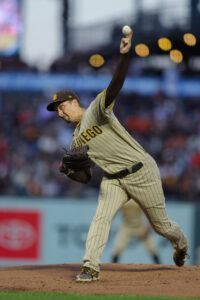Seven players in this year’s free agent class have been tagged with the qualifying offer, reports Jeff Passan of ESPN (X link). Those players are:
- Shohei Ohtani (Angels)
- Cody Bellinger (Cubs)
- Matt Chapman (Blue Jays)
- Sonny Gray (Twins)
- Josh Hader (Padres)
- Aaron Nola (Phillies)
- Blake Snell (Padres)
Previous reports had already indicated that Teoscar Hernández, Mitch Garver, J.D. Martinez and Rhys Hoskins had not received the QO. The same is true of Jorge Soler and longer-shot candidates like Kenta Maeda and Kevin Kiermaier.
The QO is valued at $20.325MM this offseason. Players have until next Tuesday to decide whether to accept. The seven players who were tagged all seemed virtual locks to both receive and decline it. It’s hard to envision anyone in this group taking a one-year pact.
Indeed, the more surprising aspect of this year’s class were the number of players who were not qualified. Last winter, 14 players were tagged with the QO. Borderline cases Joc Pederson and Martín Pérez wound up accepting. Teams were far more risk-averse this winter, shying away from the potential lofty commitment for all but the market’s top options.
[Related: Which Picks Would Each Team Forfeit By Signing A Qualified Free Agent?]
With QO decisions now made, every free agent is allowed to begin negotiations with other teams. The five-day window of exclusive negotiation with their incumbent club is over. If these players sign elsewhere, their teams would be entitled to compensation.
The Twins, as a revenue sharing recipient, stand to receive the greatest compensation. Assuming Gray beats a $50MM guarantee (a good bet), Minnesota’s compensatory pick would fall after the first round in next year’s draft. The Cubs, as a team that neither receives sharing nor paid the luxury tax, would land a choice that falls between Competitive Balance Round B and the start of the third round for Bellinger’s departure.
San Diego, Toronto and Philadelphia all surpassed the CBT threshold this year. They’d therefore receive the lowest compensation — a draft choice between Rounds 4 and 5. The Angels finished the season right on the border of the $233MM threshold and don’t yet know whether they paid the tax. As a result, they’re still awaiting word on whether they’d land the pick before the third round or after the fourth if Ohtani heads elsewhere.


